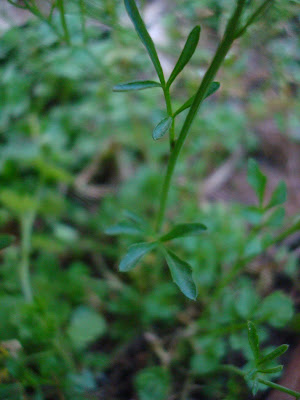 -Starts blooming mid to late winter
-Starts blooming mid to late winter-Four petals fading from light-blue to white; violet or dark-blue stripes pointing inward
-Stalk rising several inches off the ground and/or splaying outward along the ground
-Sunward facing individual flowerheads emerging from between upper stalk leaves
-Flower is showy, about the length of an adult pinky fingernail, petal tip to petal tip
You may notice that Birds Eye Speedwell, also called Persian Speedwell, begins to flower just after Hairy/Pennsylvania Bittercress, the two plants sometimes right next to one another. But this variety of Speedwell is far more showy than almost any other cool weather bloomer. South facing yards or gardens can easily erupt into cascades of violet-blue as the sun catalyzes the winter thaw, and if left alone these patches will grow even more vibrant.

Individual blooms may not last very long, since the flowerhead will detach from its stalk if disturbed, but any flowers lost are vigorously replaced. The plant will drop its flowers eventually- unwilted and intact- even if not disturbed, and these spent flowerheads will create a carpet of blue at the base of any strong Persian Speedwell patch, enhancing the visual effect of the flowers.
If you've been
 paying attention to the name of this annual, you wouldn't be surprised to learn that it is not a North American native, but- like many lawn weeds- introduced from Europe. It probably was brought over for its showy flowers, and even now is still favored by some as a low maintenance ground cover for yards. Of course, this plant has spread prolifically outside the territory of those who desire its presence and so may also be considered, by others, to be an invasive weed.
paying attention to the name of this annual, you wouldn't be surprised to learn that it is not a North American native, but- like many lawn weeds- introduced from Europe. It probably was brought over for its showy flowers, and even now is still favored by some as a low maintenance ground cover for yards. Of course, this plant has spread prolifically outside the territory of those who desire its presence and so may also be considered, by others, to be an invasive weed.There are other varieties of Speedwell which can be mistaken for Persian Speedwell. Be careful differentiating from Germander Speedwell (also called Birds Eye Speedwell) which, to my knowledge, is a much less common perennial. Other Speedwells may grow near to Persian Speedwell and bloom at the same time, but among Speedwells you will encounter, the Persian variety is likely to have the largest flowers. Regardless of the exact specimen that you may encounter, the stunning blue to blue-violet colors common to Speedwell flowers can be a welcome addition to any curbside.

Notice the number of lobes (teeth, or points) on Persian Speedwell leaves. This variety has nine or eleven teeth on its leaves.
The flower petals are rounded at the edges, with the bottom petal smaller than the other three. Oftentimes the flowers will be oriented so as to face southward, or toward the sunlight, and will rise above the rest of the leaves. The stalk may also grow horizontally or at an angle, rather than straight up into the air.
See below for more examples of Persian Speedwell.









